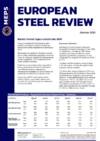Reduced slab costs trigger European plate price decline
Europe’s steel plate prices have begun to follow hot rolled coil’s recent decline, ending a period in which limited slab supply had underpinned stable values.
The dip in plate prices has reaffirmed the widespread belief that the two products’ price movements are intrinsically linked after plate values failed to keep pace with the coil market’s recent rise and fall.
MEPS International steel market analyst, Chris Jackson, said that he expects plate prices to continue fluctuating in a “narrower band” than their coil counterparts. He added: “A fall in slab costs has been the catalyst for the recent plate price drop. Slab costs and finished plate prices often mirror each other.
“Plate producers have passed on the cost benefit to their customers, in an attempt to spark activity. However, it is unlikely that they will have scope to make further concessions if they are still to cover their production costs.”
Either side of the New Year, European strip product prices increased sharply, despite a lack of demand. Steelmakers’ capacity reductions supported the shift.
In last month's edition of its European Steel Review, MEPS reported that plate prices were unable to keep pace with the rises for hot rolled coil prices and associated products.
Coil/plate price disparity
In the subsequent period, MEPS respondents, who were initially surprised by the sheer scale of mills’ price hikes, confirmed that coil producers were struggling to consolidate their recently acquired gains. This was due to the prolonged weakness in most end-user segments.
The resale values for downstream products moved up, but not to the same extent as the raw material increases.
In an attempt to plug gaps in their production schedules, European coil suppliers are now more willing to accept steel prices significantly below their targeted levels, for quarter two orders.
Initially, European plate prices appeared to be bucking the trend. Faced with the same demand constraints as coil producers, continental plate rerollers were not keen to lower their asking prices. This was because of cost pressures, notably for slabs.
Since the start of the Russia/Ukraine conflict, slab supply has been restricted.
Many European supply chains, notably in the United Kingdom, have moved away from using Russian material. Brazilian slab producers – another potential source of slab for UK buyers – prefer to sell into North America.
Consequently, Southeast Asian slab producers have become the supplier of choice for the EU and UK markets.
MEPS respondents in East Asia claim that regional producers can secure higher prices for slab exported to Europe than for finished steel products more locally.
At one stage, East Asian slab producers were securing more than USD650 per tonne from European buyers, for deliveries in quarter two, 2024.
Plate price discipline falters
Temporarily, European plate mills were able to maintain their price discipline as coil prices were falling.
This has not been maintained.
Plate buyers in Europe increasingly considered mill offers to be too high as mills’ input costs reduced.
Slab import prices have declined by USD20-30 per tonne in recent negotiations.
Furthermore, the steel market in China, and neighbouring countries, has been slow to pick up in the post-Lunar New Year period. Demand for raw materials is low and Asian steel producers’ price offers into Europe have fallen amid low booking activity.
Brazilian slab producers are also now keen to sell surplus volumes into Europe, due to recent weakness for US flat products. Additionally, it is reported that Indian slab is being offered at competitive prices, albeit only for limited volumes.
Plate demand – from both stockholders and end-users – remains low. A period of restocking activity, in mid-January, was short-lived. Most plate service centres are purchasing minimum quantities. They are not procuring for stock.
Demand for most consumer goods is weak due, in part, to the elevated cost of finance. Interest rates may have peaked but cuts are not predicted until the second half of 2024.
European plate manufacturers that may have been quietly confident about mitigating price deterioration during the first two months of 2024 are now making concessions.
They may have less scope to reduce prices than their coil contemporaries due to a need to cover their production costs, however.
“For the first two months of the year, plate rises did not scale the heights of those experienced for coil, but it is likely they will not reach similar depths now either,” said Jackson.
- Monthly insight on the European carbon steel market is published in MEPS International's European Steel Review. The monthly report provides subscribers with steel prices, indices, market commentary and forecasts from across the globe.

Source:
European Steel Review
The MEPS European Steel Review is an informative, concise and easy-to-use monthly publication, offering unique professional insight into European carbon steel prices.
Go to productRequest a free publication





